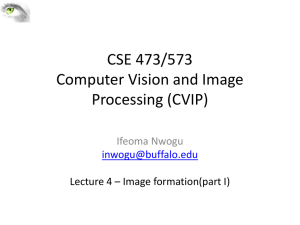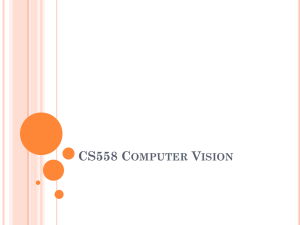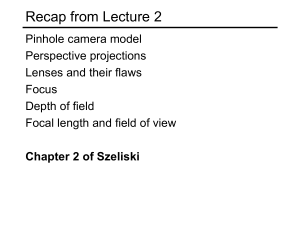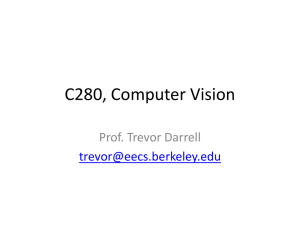lec01_cameras_photogrammetry
advertisement
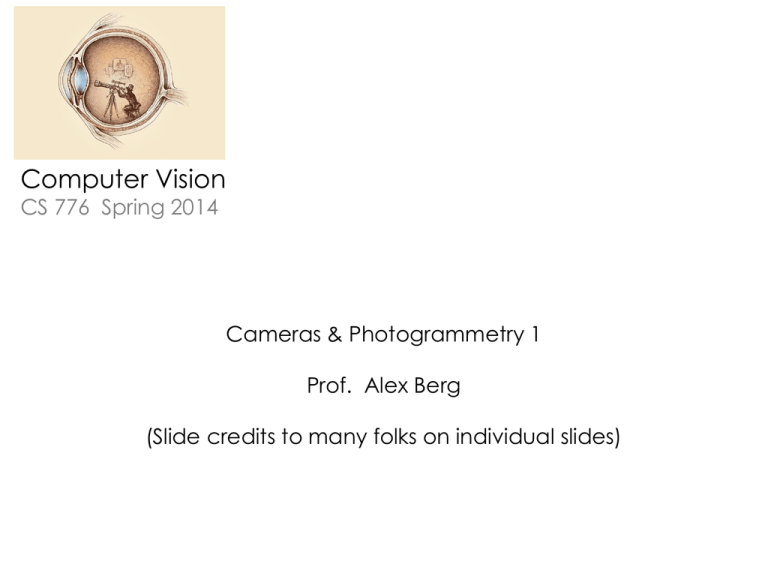
Computer Vision CS 776 Spring 2014 Cameras & Photogrammetry 1 Prof. Alex Berg (Slide credits to many folks on individual slides) Cameras & Photogrammetry 1 Albrecht Dürer early 1500s Brunelleschi, early 1400s Let’s design a camera Idea 1: put a piece of film in front of an object Do we get a reasonable image? Slide by Steve Seitz Pinhole camera Add a barrier to block off most of the rays Slide by Steve Seitz Pinhole camera • • Captures pencil of rays – all rays through a single point: aperture, center of projection, focal point, camera center The image is formed on the image plane Slide by Steve Seitz Pinhole cameras everywhere Tree shadow during a solar eclipse photo credit: Nils van der Burg http://www.physicstogo.org/index.cfm Slide by Steve Seitz Dimensionality reduction: from 3D to 2D 3D world 2D image Point of observation What is preserved? • Straight lines, incidence What is not preserved? • Angles, lengths Slide by A. Efros Figures © Stephen E. Palmer, 2002 Modeling projection y f z x • To compute the projection P’ of a scene point P, form the visual ray connecting P to the camera center O and find where it intersects the image plane • All scene points that lie on this visual ray have the same projection in the image • Are there scene points for which this projection is Source: J. Ponce, S. Seitz undefined? Modeling projection y f z x The coordinate system • The optical center (O) is at the origin • The image plane is parallel to xy-plane (perpendicular to z axis) Projection equations • Derived using similar triangles: x y ( x, y , z ) ( f , f ) z z Source: J. Ponce, S. Seitz Projection of a line image plane vanishing point camera center line in the scene • What if we have another line in the scene parallel to the first one? Slide by Steve Seitz Vanishing points • Each direction in space has its own vanishing point • All lines going in that direction converge at that point • Exception: directions parallel to the image plane Vanishing points • Each direction in space has its own vanishing point • All lines going in that direction converge at that point • Exception: directions parallel to the image plane • What about the vanishing line of a plane? Slide by Steve Seitz The horizon camera center ground plane • Vanishing line of the ground plane – All points at the same height as the camera project to the horizon – Points higher than the camera project above the horizon – Provides way of comparing height of objects Slide by Steve Seitz The horizon Slide by Steve Seitz Perspective cues Slide by Steve Seitz Perspective cues Slide by Steve Seitz Perspective cues Slide by Steve Seitz Comparing heights Vanishing Point Slide by Steve Seitz Measuring height 5 4 3 5.4 Camera height 3.3 2.8 2 1 What is the height of the camera? Slide by Steve Seitz Perspective in art Masaccio, Trinity, Santa Maria Novella, Florence, 1425-28 One of the first consistent uses of perspective in Western art Slide Svetlana Lazebnik (at least partial) Perspective projections in art well before the Renaissance From ottobwiersma.nl Also some Greek examples, So apparently pre-renaissance… Perspective distortion • What does a sphere project to? M. H. Pirenne Perspective distortion • What does a sphere project to? Perspective distortion • The exterior columns appear bigger • The distortion is not due to lens flaws • Problem pointed out by Da Vinci Slide by F. Durand Perspective distortion: People Modeling projection y f z x x y Projection equation: ( x, y, z ) ( f , f ) z z Source: J. Ponce, S. Seitz Homogeneous coordinates x y ( x, y , z ) ( f , f ) z z Is this a linear transformation? • no—division by z is nonlinear Trick: add one more coordinate: homogeneous image coordinates homogeneous scene coordinates Converting from homogeneous coordinates Slide by Steve Seitz Perspective Projection Matrix Projection is a matrix multiplication using homogeneous coordinates 1 0 0 0 1 0 0 0 1 / f x 0 x y x y 0 y ( f , f ) z z z 0 z / f divide by the third coordinate 1 In practice: lots of coordinate transformations… 2D point (3x1) = Camera to pixel coord. trans. matrix (3x3) Perspective projection matrix (3x4) World to camera coord. trans. matrix (4x4) 3D point (4x1) Whole “pipeline” é w p ù é ê p i ú ê sx ê w p p j ú = ê k2 ê ú ê êë w p úû êë 0 2D point (3x1) = k1 sy 0 0 ùé 1 0 0 úê 0 úê 0 1 0 úê 0 0 1 / f 1 úûë Camera to pixel coord. trans. matrix (3x3) é 0 ùê úê 0 úê 0 úûê êë Perspective projection matrix (3x4) Just one matrix (+ dehomogenization) but with a special structure r11 r12 r13 r21 r22 r23 r31 r32 r33 0 0 0 t x ùé x úê t y úê y ú tz úê z ê 1 úûë 1 World to camera coord. trans. matrix (4x4) é é w p ù ê ê p i ú ê ê wp p j ú = ê ê ú ê êë w p úû ê ë ù ú ú ú ú û 3D point (4x1) a b c d e f g h i j k l ùé úê úê úê úê úë û x ù ú y ú z ú ú 1 û Orthographic Projection Special case of perspective projection • Distance from center of projection to image plane is infinite Image World • Also called “parallel projection” • What’s the projection matrix? Slide by Steve Seitz More reading & thought problems Shape from Chebyshev nets, Koendereink & van Dorn Accidental pinhole and pinspeck cameras. Torralba & Freeman Show that a sphere can look like a non-circular under perspective projection. What does a pinhole camera image look like as you make the pinhole larger?

